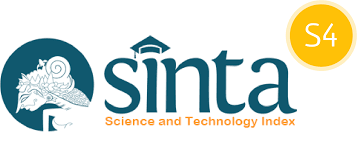Biodegradasi Bioplastik Berbasis Pati Menggunakan Isolat Fungi Indigenous Asal Tempat Pembuangan Akhir Gunung Tugel, Kabupaten Banyumas
Abstract
The use of plastic in Indonesia, especially as packaging, is very popular among the public, because it is practical and has many uses. Plastic consumption in 2020 even reached 67.8 million tons per day. Therefore, one way to overcome this problem is to use and produce biodegradable plastics or bioplastics. Biodegradation of bioplastics can be done with fungi. The potential place to find bioplastic degrading fungi is the Gunung Tugel Ex-Final Disposal Site (TPA). Considering the fact that bioplastics have a fairly good level of degradation, in this study a starchbased biodegradation test will be carried out using isolates of indigenous fungi originating from Ex-TPA Gunung Tugel using the method of calculating the weight loss of bioplastics (weight loss). This study aims to obtain starch-based bioplastic degrading fungi isolates from Ex-TPA Gunung Tugel, Banyumas Regency and determine the highest biodegradability ability of starchbased bioplastics by fungal isolates from Ex-TPA Gunung Tugel, Banyumas Regency. The results showed that isolates of indigenous fungi that had the potential to degrade starch-based bioplastics from Ex-TPA Gunung Tugel, Banyumas Regency were obtained from the genus Aspergillus (GT2 isolate) and Penicillium (GT1, GT3, GT4, GT5, and GT6) isolate. The highest biodegradability of starch-based bioplastics was found by fungi from the genus Aspergillus, namely, isolate GT2 with a weight loss of 21.84%. The biodegradation occurs due to the activity of endoamylase, exoamylase, and glucanase enzymes produced by fungi. The observation of the texture of the bioplastic resulted in a significant change in color, namely from the white bioplastic sheet to brownish. These observations also showed the attachment of fungal mycelium on the surface of the bioplastic accompanied by a hollow and uneven surface of the bioplastic. Key words: Biodegradation, Starch-based bioplastic, Indigenous Fungi, TPA.
References
Ade, S., & Purba, R. 2018. Isolasi Dan Identifikasi Jamur Pendegradasi Bioplastik Berbasis Pati. "Skripsi". Fakultas Biologi, Universitas Gadjah Mada.
Adhikari, D. Et Al. 2016. Degradation Of Bioplastiks In Soil And Their Degradation Effects On Environmental Microorganisms. Journal Of Agricultural Chemistry And Environment 05(01): P.23–34.
Ainiyah, D., & Shovitri, M. 2014. Bakteri Tanah Sampah Pendegradasi Plastik Dalam Kolom Winogradsky. Jurnal Sains Dan Seni Pomits 3(2): P.63–66.
Angraini, Dewi Nur, & Usman, M. 2015. Biolink Uji Aktivitas Dan Identifikasi Jamur Rhizosfer Pada Tanah Perakaran Tanaman Pisang ( Musa Paradisiaca ) Terhadap Jamur Fusarium Test Activity And Identification Of Mushrooms On Soil Crop Root Rhizosphere Banana ( Musa Paradisiaca ) Against Fusariu. Jurnal Biologi Lingkungan, Industri, Dan Kesehatan 1(2): P.89–98.
Atlas, R.M. 2010. Handbook of Microbiological Media Fourth Edition. Francis: CRC Press.
Aziz, I.R., Muthiadin, C., & Hafsan, H. 2019. Biodegradasi Plastik Ldpe Hitam Dan Putih Pada Sampah Tpa Antang Dalam Kolom Winogradsky. Al-Kauniyah: Jurnal Biologi 12(2): P.164–170.
Badan Pusat Statistik. 2020. Statistik Lingkungan Hidup Indonesia. BPS. Jakarta
Bhardwaj, H., Gupta, R. and Tiwari, A. 2012. Microbial Population Associated with Plastic Degradation. Open Access Scientific Reports. 1(5): 1-4.
Deepika, S., & Madhuri, R.J. 2015. Biodegradation Of Low Density Polyethylene By Micro-Organisms From Garbage Soil. Journal Of Experimental Biology And Agricultural Sciences 3(1): P.15–21. Available At: Http://Www.Jebas.Org.
Dineshraj, D., & Ganesh, P. 2016. Screening And Characterization Of Isolatd Fungi From Plastic Waste Dump Yard Sites. Ijsr -International Journal Of Scientific Research 301(1): P.301–302.
Emita, H., Cicilia, N.P., & Pujiati. 2017. Karakteristik Isolat Kapang Endogenus Pendegradasi Limbah Plastik. Prosiding Seminar Nasional Simbiosis Ii (September): P.378–388.
Folino, A., Karageorgiou, A., Calabrò, P.S., & Komilis, D. 2020. Biodegradation Of Wasted Bioplastiks In Natural And Industrial Environments: A Review. Sustainability (Switzerland) 12(15): P.1–37.
Gajendiran, A., Krishnamoorthy, S. and Abraham, J., 2016. Microbial degradation of low-density polyethylene (LDPE) by Aspergillus clavatus strain JASK1 isolatd from landfill soil. 3 Biotech, 6(1), p.52.
Gandjar, I., R.A. Samson, K. van den Tweel-Vermeulen, A. Oetari & I. Santoso. 1999. Pengenalan kapang tropik umum. Jakarta: Yayasan Obor Indonesia.
Gautam, A.K., & Bhadauria, R. 2012. Characterization Of Aspergillus Species Associated With Commercially Stored Triphala Powder. African Journal Of Biotechnology 11(104): P.16814–16823.
Hoegh-Guldberg, O. Et Al. 2015. Plastic Waste Inputs From Land Into The Ocean. Science (September 2014): P.1655–1734.
Indumathi, A., & Kavitha, K.K. 2020. High Density Polyethylene (HDPE) DegradationIn Aqueous Solution By Fungi Isolatd From Garbage Landfills At Thanjavur, Tamil Nadu, India. International Journal Of Current Microbiology And Applied Sciences 9(8): P.1874–1882.
Intandiana, S., Dawam, A.H., Denny, Y.R., Septiyanto, R.F., & Affifah, I. 2019. Pengaruh Karakteristik Bioplastik Pati Singkong Dan Selulosa Mikrokristalin Terhadap Sifat Mekanik Dan Hidrofobisitas. Educhemia (Jurnal Kimia Dan Pendidikan) 4(2): P.185.
Janet, O.W., & Kelechi, H. 2016. Microorganisms Associated With Dump Sites In Port Harcourt Metropolis, Nigeria. Journal Of Ecology And The Natural Environment 8(2): P.9–12.
Kumar, S., Das, M.P., Jeyanthi Rebecca, L., & Sharmila, S. 2013. Isolation And Identification Of Ldpe Degrading Fungi From Municipal Solid Waste. Journal Of Chemical And Pharmaceutical Research 5(3): P.78–81.
Muhonja, C.N., Makonde, H., Magoma, G., & Imbuga, M. 2018. Biodegradability Of Polyethylene By Bacteria And Fungi From Dandora Dumpsite Nairobi-Kenya. Plos One 13(7): P.1–17.
Munir, E., Harefa, R.S.M., Priyani, N., & Suryanto, D. 2018. Plastic Degrading Fungi Trichoderma Viride And Aspergillus Nomius Isolatd From Local Landfill Soil In Medan. Iop Conference Series: Earth And Environmental Science 126(1).
Nchedo Ariole, C., & George-West, O. 2020. Bioplastik Degradation Potential Of Microorganisms Isolatd From The Soil. American Journal Of Chemical And Biochemical Engineering 4(1): P.1.
Nissa, R.C., Fikriyyah, A.K., Abdullah, A.H.D., & Pudjiraharti, S. 2019. Preliminary Study Of Biodegradability Of Starch-Based Bioplastiks Using Astm G21-70, Dip-Hanging, And Soil Burial Test Methods. Iop Conference Series: Earth And Environmental Science 277(1).
Obire, O., Nwaubeta, O., & Adue, B.N. 2002. Microbial Community Of A Waste- Dump Site. Journal Of Applied Sciences And Environmental Management 6(1). pp.18-26.
Lazuardi, G., & Sari E. 2013. Preparation And Characterization Based Bioplastik Chitosan And Cassava Starch With Glycerol Plazticizer. UNESA Journal Of Chemistry 2(3): P.161–166.
Sankhla, I.S., Sharma, G., & Tak, A. 2020. Fungal Degradation Of Bioplastsankhla, I.S., Sharma, G., & Tak, A. 2020. Fungal Degradation Of Bioplastiks: An Overview. 12-821007-9.00004-8.
Shimao, M. 2001. Biodegradation Of Plastics Masayuki Shimao. Current Opinion In Biotechnology 12: P.242–247.
Urbanek, A.K. Rymowicz, W., Strzelecki, M.C., Kociuba, W., Franczak, Ł., Mirończuk, A.M., 2017. Isolation And Characterization Of Arctic Microorganisms Decomposing Bioplastiks. Amb Express 7(1). 148-158.
Watanabe, T., 2010. Pictorial atlas of soil and seed fungi: morphologies of cultured fungi and key to species. CRC press.
Wati, R.I. 2020. Uji Kemampuan Biodegradasi Sampah Plastik Polyethylene (Pe) Oleh Bakteri Pendegradasi Plastik Yang Diisolasi Dari Tempat Pembuangan Akhir (Tpa) Jabon Sidoarjo.
Williams, J.O. & Hakam, K., 2016. Microorganisms associated with dump sites in Port Harcourt Metropolis, Nigeria. Journal of Ecology and the Natural Environment, 8(2), pp.9-12.
Yanti, N.A., Sriwahyuni, E., La Omi, N.R., Muhiddin, N.H. & Ahmad, S.W., 2019. The Potential of Lipolytic Filamentous Fungi Isolatd from Landfill Soil as Poly-β-Hydroxybutirate (PHB) Bioplastik Degrader. bioRxiv.
Yunar, V. 2011. Evaluasi Biodegradabilitas Plastik Berbahan Dasar Campuran Pati Dan Polietilen Menggunakan Astm G21-09, Uji Mikroorganisme Dan Uji Lapangan. "Skripsi". Fakultas Teknik, Universitas Indonesia.
















